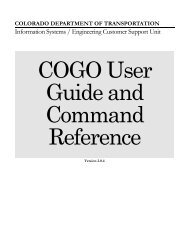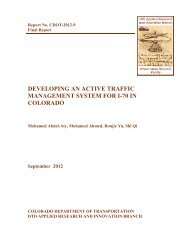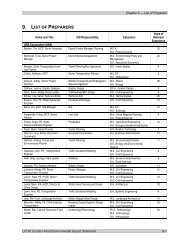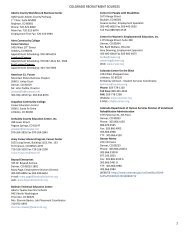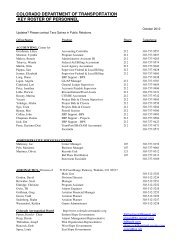Chapter 5 THE AUTOMOBILE AGE BEGINS, 1890-1930 - Colorado ...
Chapter 5 THE AUTOMOBILE AGE BEGINS, 1890-1930 - Colorado ...
Chapter 5 THE AUTOMOBILE AGE BEGINS, 1890-1930 - Colorado ...
Create successful ePaper yourself
Turn your PDF publications into a flip-book with our unique Google optimized e-Paper software.
5.3 The Romance of the Open Road: The Early Years of Automobile Touring<br />
The automobile reawakened an element in the national character to travel whenever, wherever<br />
one pleased. Unfortunately, the highways of the early 20 th century could only take a driver so<br />
far, as none of the states, or any county in those states, could boast of a completed highway<br />
system.<br />
During the 1910s, loose alliances of motorists, automobile industry executives, community<br />
boosters, and speculators envisioned the construction of transcontinental automobile highway.<br />
On August 1, 1912, <strong>Colorado</strong>’s representative in the U.S. House, Edward T. Taylor, introduced a<br />
bill “establishing the Lincoln memorial highway from Boston, Mass. to San Francisco, Cal.”<br />
The bill died in the House Agriculture Committee, but the name caught the nation’s attention<br />
(Wolfe, 1999: 4). A little more than a month later on September 6, Carl G. Fisher, developer of<br />
the Indianapolis Motor Speedway, presented his plans for the creation of a Coast-to-Coast<br />
Highway to an approving audience of automobile manufacturers. By the following summer,<br />
various individuals and groups pledged $4 million toward construction. In July 1913, organizers<br />
agreed to call their venture the Lincoln Highway Association (AASHO, 1952: 109).<br />
The Association planned to build an automobile highway along the most direct route from New<br />
York to San Francisco during the mid-1910s. The auto enthusiasts faced a decision similar to the<br />
Union Pacific in 1870 – how to build a transcontinental road that would safely and economically<br />
cross the Rocky Mountains. Like Union Pacific, the Lincoln Association selected South Pass in<br />
southern Wyoming as the most practical route over the Continental Divide. Not wanting to loose<br />
tourist dollars to Wyoming, the Denver Chamber of Commerce and Governor Elias M. Ammons<br />
attempted to broker a deal with the Association’s leadership to have the Association recognize a<br />
spur from Julesburg in northeastern <strong>Colorado</strong> along the path of today’s US 6 to Denver and then<br />
north to Fort Collins before following the North-South Highway (modern I-25) back to<br />
Cheyenne and onto the main road as part of the main Lincoln Highway. The state promised to<br />
maintain the road at no cost to the Association. A rough and rocky drive by Lincoln Highway<br />
officials through Western <strong>Colorado</strong> did not help the state’s chances with the Association and its<br />
leadership viewed <strong>Colorado</strong> as a “state full of malcontents.” Relations grew to the point where<br />
Final<br />
CDOT Historic Highway Context<br />
5-4





